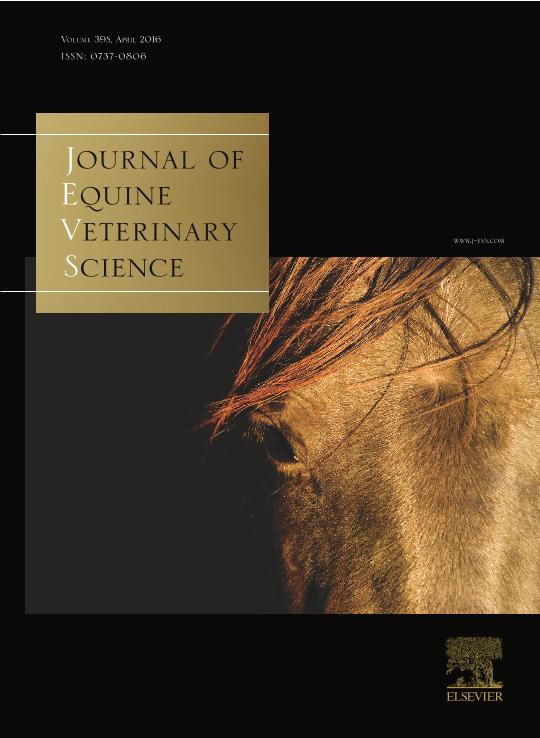Mostrar el registro sencillo del ítem
dc.contributor.author
Storani, Carlos Alberto

dc.contributor.author
Jacobo, Roberto Armando

dc.contributor.author
Cipolini, M. F.
dc.contributor.author
Martínez, D. E.
dc.contributor.author
Espasandin, Ana Gabriela

dc.contributor.author
Paine, V.
dc.contributor.author
Godoy, J. A.
dc.date.available
2021-07-20T02:45:41Z
dc.date.issued
2016
dc.identifier.citation
Seropositivity of Equine infectious anemia by 2005 to 2014 in provinces of north-west of Argentina; 10th International Equine Infectious Diseases Conference; Buenos Aires; Argentina; 2016; S34-S35
dc.identifier.issn
0737-0806
dc.identifier.uri
http://hdl.handle.net/11336/136453
dc.description.abstract
Equine infectious anemia (EIA) is a disease caused by a lentivirus specific from equidae family. It had been diagnosed in all continents except in Antarctica. Morbidity and mortality depends on the sensibility of the population and the virus strains. The clinics symptoms of the acute presentation tend to be unspecific and infected horses often recover and remain as chronic carriers. EIA virus (EIAV) infection can result in either an acute or chronic (swamp fever) disease that typically transitions to a life-long,unapparent (asymptomatic) infection. The virus of EIA is transmitted by blood or contaminated blood derivatives, but in the nature the main way of transmission is by bloodsuckinginsects. Diagnosis is based on serological testing, being the agar gel immunodiffusion test (AGID) the test prescribed by OIE for international trade of horses. The purpose of this study was to evaluate EIA presentation in northern-west provinces of Argentina, based on results of AGID from serum samples. The results were compiled from a laboratory which belongs to a netof laboratories regulated by the sanitary authorities (SENASA) and is located in Corrientes city. Datum obtained correspond to 56.391 samples obtained from equines of Corrientes (n¼48.661), Misiones (n¼6.722) and Chaco (n¼1.008) provinces, analyzed between 2005 and 2014. A total of 1.954 animals were positives in this period. Percentage of positivity (PP) was determinate, discriminated by province and year. The average PP was determinate by province for the period between 2005 and 2012.In all cases, tendencies shows the decrement of PP from 2005 to 2012 (Misiones, Chaco) or 2014 (Corrientes). InCorrientes province, the rank of PP was 6,03% (2005) to 1,24% (2013); in Misiones was from 4,25% (2005) to 0,8% (2010) and in Chaco was from 20,05% (2008) to 0% (2005 and 2006). The average PP for the period between 2005 and 2012 was 3,77%, 3, 35% and 5,91% in Corrientes, Misiones and Chaco, respectively. Since that analysis was made from a non-randomly samplingfrom serum that arrives to diagnosis in laboratory, this findings cannot be expressed in terms of prevalence. For the same reasons, the PP reached is lower than those reported for equines of the same areas in prevalence studies, because the animals that are frequently controlled are those destined to sports and shows activities and their situation does not reflect what occurs in equines destined to do farm tasks, which are often excluded from controls and where the disease prevalence is higher. This analysis shows, however, a tendency which is in agreement with reported by other authors for the provinces studied, with ahigher prevalence in Chacowhen compared with Corrientes and Misiones provinces.
dc.format
application/pdf
dc.language.iso
eng
dc.publisher
Elsevier

dc.rights
info:eu-repo/semantics/openAccess
dc.rights.uri
https://creativecommons.org/licenses/by-nc-nd/2.5/ar/
dc.subject
Diagnosis
dc.subject
Serology
dc.subject
Equine
dc.subject.classification
Ciencias Veterinarias

dc.subject.classification
Ciencias Veterinarias

dc.subject.classification
CIENCIAS AGRÍCOLAS

dc.title
Seropositivity of Equine infectious anemia by 2005 to 2014 in provinces of north-west of Argentina
dc.type
info:eu-repo/semantics/publishedVersion
dc.type
info:eu-repo/semantics/conferenceObject
dc.type
info:ar-repo/semantics/documento de conferencia
dc.date.updated
2021-07-05T16:40:27Z
dc.journal.volume
39
dc.journal.number
supl.
dc.journal.pagination
S34-S35
dc.journal.pais
Estados Unidos

dc.journal.ciudad
New York
dc.description.fil
Fil: Storani, Carlos Alberto. Universidad Nacional del Nordeste. Facultad de Ciencias Veterinarias; Argentina
dc.description.fil
Fil: Jacobo, Roberto Armando. Universidad Nacional del Nordeste. Facultad de Ciencias Veterinarias; Argentina
dc.description.fil
Fil: Cipolini, M. F.. Universidad Nacional del Nordeste. Facultad de Ciencias Veterinarias; Argentina
dc.description.fil
Fil: Martínez, D. E.. Universidad Nacional del Nordeste. Facultad de Ciencias Veterinarias; Argentina
dc.description.fil
Fil: Espasandin, Ana Gabriela. Universidad Nacional del Nordeste. Facultad de Ciencias Veterinarias; Argentina. Consejo Nacional de Investigaciones Científicas y Técnicas. Centro Científico Tecnológico Conicet - Nordeste; Argentina
dc.description.fil
Fil: Paine, V.. No especifíca;
dc.description.fil
Fil: Godoy, J. A.. No especifíca;
dc.relation.alternativeid
info:eu-repo/semantics/altIdentifier/url/https://www.sciencedirect.com/science/article/pii/S0737080616001076
dc.relation.alternativeid
info:eu-repo/semantics/altIdentifier/url/https://doi.org/10.1016/j.jevs.2016.02.076
dc.conicet.rol
Autor

dc.conicet.rol
Autor

dc.conicet.rol
Autor

dc.conicet.rol
Autor

dc.conicet.rol
Autor

dc.conicet.rol
Autor

dc.conicet.rol
Autor

dc.coverage
Internacional
dc.type.subtype
Conferencia
dc.description.nombreEvento
10th International Equine Infectious Diseases Conference
dc.date.evento
2016-04-04
dc.description.ciudadEvento
Buenos Aires
dc.description.paisEvento
Argentina

dc.type.publicacion
Journal
dc.description.institucionOrganizadora
University of Kentucky
dc.source.revista
Journal of equine Veterinary Science
dc.date.eventoHasta
2016-04-08
dc.type
Conferencia
Archivos asociados
